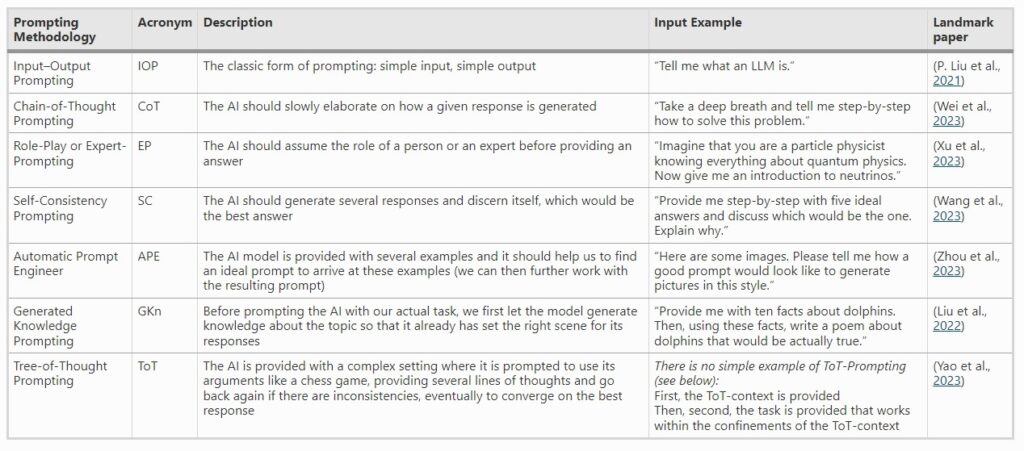Advances in artificial intelligence (AI), specifically in large language models (LLMs), are adding a new way learners may access information. Unlike traditional search engines that link to websites, LLMs directly answer user questions using a vast amount of information (Stadler et al., 2024). An LLM uses machine learning to process large datasets, enabling it to understand context and generate human-like text by predicting the next word in a sequence, as well as handling other data representations such as music and images. As educators, we can guide learners in identifying their areas of inquiry and help them formulate the right questions, ultimately aiming to enhance their learning and foster critical thinking. As one particular study showed, learning to prompt effectively can even help students realize more about the limits of AI, which inevitably fosters their AI literacy (Theophilou et al., 2023). This blog offers different strategies and recommended practices for prompting when interacting with AI tools.
Approaches to Prompting
Prompt engineering involves carefully designing inputs to get specific responses or behaviors from AI systems. The prompt approach will influence responses, and prompt engineering is an iterative refinement process. There are several established prompting methods, as summarized in the table below (from Embracing the future of Artificial Intelligence in the classroom: the relevance of AI literacy, prompt engineering, and critical thinking in modern education).

Kaden (2024) shared three relevant prompting approaches for educators; structured approach, rhetorical approach, and the C.R.E.A.T.E framework.
Structured Approach (Cummings)
Essentially there are three parts of a structured prompt, typically in the following order; task, context, and content.
- Start with a role and a goal. This is where you define what you want the AI to do. For example, summarize text, analyze data, apply a framework etc. Broadly describe the overarching aim and purpose of the task.
- Provide context and background to help the AI understand why, how, and the environment behind the task.
- Provide any reference content the AI will need to complete the task. Make your expectations explicit and detailed by supplying notes, previous outputs or relevant examples.
Rhetorical Approach (Bauer)
The approach involves describing the main claim (the most critical point) and then your rhetorical situation.
- Start with your main claim or argument and choose the most suitable rhetorical technique (for example, choose a case to refer to, identify a comparison, or evoke a recognized authority)
- The audience. For example, what is the knowledge and interest level in the topic? What are the audience’s preferences or concerns?
- The context. Where will the audience read this?
- The author and ethos. This might include your role or credentials.
- Pathos. What should your audience feel or believe?
- Logos. What logical points do you want to emphasize?
- Arrangement. For example, chronological or alphabetical.
- Style and delivery. For example, “Limit your response to 100 words and avoid using the second person.”
C.R.E.A.T.E Framework (Birss)
In the C.R.E.A.T.E. approach, the AI is addressed as “you.” This approach resembles an instructor’s assignment.
- Character – Describe the role the AI is to assume.
- Request – Clearly and specifically define the request. “I want you to…”
- Examples – Give examples if you have them
- Additions – Refine the task. Describe a point of view to consider or a style to use
- Type of Output – For example, a 100-word summary or a chronologically organized bio
- Extras – Any further information you wish to provide, including reference text
Prompts for Images


While text generators like ChatGPT can respond to basic prompts, AI image generators often require more detailed input to achieve the desired result. Keep in mind that image generators such as Midjourney, DALL-E, Adobe Firefly, DreamStudio, and other tools have different parameters and platform specific features. Generally, effective AI image prompts require details and concrete wording with the a basic stucture; subject, description and style/aesthetic.
- Content, including the actions for the subject, how they are doing the actions and the mood and atmosphere of the image.
- Add the artform, style and artist reference. See 70+ AI art styles to experiment with.
- Add more details such as framing (how the content is positioned in the image), lighting (e.g., soft light, hard light, dramatic light, morning, sunset), colour scheme, and level of detail.

“A great horned owl in a tree, intimidating staring down, foggy evening, forest in the background, emulate Nikon D6 high shutter speed action shot, soft yellow lighting, close up shot, realistic”, image generated by Adobe Firefly, Sept 24, 2024.

Best Practices
Educators can support students to avoid mishandling sensitive data and personal information. Start by evaluating the AI tool to understand the data collection process. Examine the tool’s official documentation, which often includes details on data collection methods, types of data collected, and purposes for collection. AI tools may incorporate submissions or inputs into their training data, so review the data collection settings for options to turn this off. Look for information about compliance with data protection regulations (e.g., FIPPA, Protection and Privacy at VIU). Understand where the data is sourced from—whether it’s user-generated, third-party data, or public datasets. Also, support students to practice prompt engineering that minimizes the risk by removing or modifying person identifiers from any prompts and share only what is necessary. Lastly, encourage students to critique and verify the outputs. This might involve cross-referencing the AI’s responses with reliable sources or seeking feedback from colleagues.
Additionally, help students recognize how the prompting can influence bias. To minimize bias, it’s important to be specific and choose your wording intentionally. Always review the AI’s output—don’t assume it’s true or error-free. Read it carefully, question it, and make sure nothing is out of place. After reviewing, critically evaluate the work. For example, if you’ve created an image, ask yourself whether the AI provided a diverse representation of races, ages, gender expressions, body sizes, and abilities. If the AI-generated content lacks varied representation, add beyond what the AI provided.
Prompting Practice
The Centre for Innovation and Excellence in Learning (CIEL) invites you to participate in a two-part Generative Artificial intelligence competition this Fall. The aim of this competition is to encourage faculty to experiment with a variety of generative AI tools to understand their capabilities and limitations, with the goal of improving students’ learning and fostering critical thinking. Additionally, the competition seeks to engage conversations about the benefits and challenges of AI implementation across various disciplines. See the The Not-So-Scary Gen AI Image Competition blog for details.
References
Kadel, S. N. (2024). Prompt engineering: The art of getting what you need from generative AI. Georgia Tech, Ivan Allen College of Liberal Arts. From https://iac.gatech.edu/featured-news/2024/02/AI-prompt-engineering-ChatGPT
Stadler, M., Bannert, M., & Sailer, M. (2024). Cognitive ease at a cost: LLMs reduce mental effort but compromise depth in student scientific inquiry. Computers in Human Behavior, 160, 108386. https://doi.org/10.1016/j.chb.2024.108386
Theophilou, E., Koyutürk, C., Yavari, M., Bursic, S., Donabauer, G., Telari, A., Testa, A., Boiano, R., Hernandez-Leo, D., Ruskov, M., Taibi, D., Gabbiadini, A., & Ognibene, D. (2023). Learning to Prompt in the Classroom to Understand AI Limits: A Pilot Study. In R. Basili, D. Lembo, C. Limongelli, & A. Orlandini (Eds.), AIxIA 2023 – Advances in Artificial Intelligence (pp. 481–496). Springer Nature Switzerland. https://doi.org/10.1007/978-3-031-47546-7_33
Walter, Y. (2024). Embracing the future of artificial intelligence in the classroom: The relevance of AI literacy, prompt engineering, and critical thinking in modern education. International Journal of Educational Technology in Higher Education, 21, 15. https://doi.org/10.1186/s41239-024-00448-3
Subscribe
To receive an email when we post new content you can subscribe to our blog: